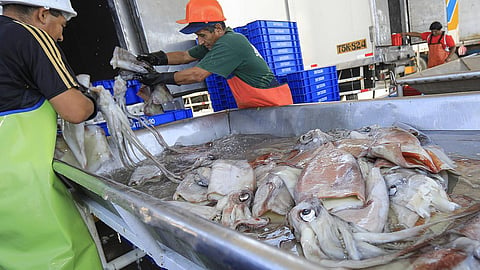

Preparing jumbo flying squid for transport after landing in Peru.
Photo: Produce.
After the new Fisheries Management Regulation was approved in March to manage the exploitation of the jumbo flying squid fishery while ensuring its sustainability, the Peruvian Ministry of Production (Produce) has now announced new measures to further strengthen the protection of this species, also known as Humboldt squid (Dosidicus gigas).
Following the scientific recommendations of the Peruvian Sea Institute (Imarpe), and with the specific objective of improving and managing the fishery, this June's package of measures responds to the need to guarantee the responsible use of this important hydrobiological resource of the country.
Involving 4,475 artisanal vessels, and generating direct employment for more than 14,000 fishermen, benefiting some 70,000 people in the country, the jumbo flying squid is being one of the protagonist species in the 2025 fishing campaign in Peru, specifically, the one with the largest increase in landings in April with an increase of 540.3%.
In addition, according to Imarpe's most recent technical report, this fishery is currently showing a positive behavior in its population volume, with biological and fishing indicators that reflect a progressive recovery of the resource.
Therefore, also earlier this month, Produce announced that the total allowable catch (TAC) of jumbo flying squid, initially set at 190,000 tons, would be increased by 100,000 tons to 290,000 tons, while the extraction period would be extended until August 31 of this year.
However, the Ministry of Production pointed out that this good trend also confirms the need to continue strengthening the management of the fishery, to avoid future overexploitation and ensure the long-term use of the resource.
As mentioned above, the new Produce resolution emphasizes how fishing is carried out, incorporating control mechanisms and best operational practices on board.
Among the main measures is the exclusive use of the squid-jig as a fishing gear. Recommended by the Imarpe due to its selectivity and low environmental impact, as previously reported by WeAreAquaculture, its operability allows a specific catch without generating negative impacts on other species or the marine environment.
Likewise, among the measures highlighted by the Peruvian Ministry of Production were the catch limits per fishing operation according to the hold capacity of the artisanal vessels, the mandatory use of ice for the immediate conservation of the resource in a 2 x 1 ratio, and the obligation to have inspection reports for each landing.
Moreover, the new measures also regulate the transport of the resource, which must be carried out exclusively in isothermal vehicles to guarantee its safety, allowing the vehicle to transport resources from more than one artisanal fishing vessel.
Produce pointed out that these measures seek not only to preserve the balance of the marine ecosystem, but also to protect the economic activity of the thousands of families that depend directly on this fishery.
The jumbo flying squid represents more than 40% of national landings and generates employment both at sea and on land, through processing, transportation, and marketing chains. With a preventive approach, the different measures that Produce has been taking are committed to management that combines productivity with sustainability.
"The real progress lies in ordering the fishery and providing more dignified and profitable conditions for our fishermen. It's not just about catching more, but about doing it better, with clear rules, effective control, and responsibility with the sea," claimed the Peruvian Vice Minister of Fisheries and Aquaculture, Jesús Barrientos.
Barrientos added that these types of decisions aim to consolidate modern fishing, based on scientific evidence, traceability, and social and environmental sustainability, something that, as he pointed out last March, will allow Peru to position itself more solidly in the demanding international markets.
